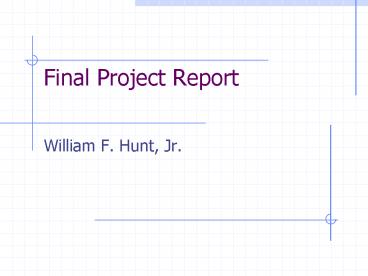Final Project Report PowerPoint PPT Presentation
1 / 14
Title: Final Project Report
1
Final Project Report
- William F. Hunt, Jr.
2
Outline
- Executive Summary
- Introduction/Background
- Objectives
- Methods and Analysis
- Conclusions and Recommendations
3
Executive Summary
- Briefly describe what you found.
- Dr. Ellis Cowling - turn significant results into
simple sentences. - Capture the attention of the decision maker.
4
A Statistical Methodology for Corroborating
Emission Inventories for Volatile Organic
Compounds and Nitrogen Oxides Louise Camalier,
Brendan Yoshimoto Brian Stines
- Describe the VOC/NOx Emission Inventory
Discrepancy In Houston. - Why do we care?
- Goes to the heart of the air quality management
process. - Future predictions are only as good as the
emission inventory. - Can we determine what the typical ozone day
inventory represent? How are upsets,
malfunctions, spills, etc. addressed? - Way has the study been extended to Atlanta?
- Can the results in Houston be replicated?
- How can the statistical method that normalizes
air quality data by removing the effect of wind
speed be used? - Corroborate emission inventories
- Develop correction factors to take malfunctions,
etc. into account - Enforcement identify excessive pollution
problems
5
Four Projects Four Teams
- NCDENR Air Division Project Is the Fine
Particulate Matter Air Pollution Non-attainment
Problem in Hickory and Lexington, NC Regional or
Local? (John White) - NCDENR Water Division Project - Is there a
relationship between water chemistry and bug
abundance? (Jay Bibby, Audria Humes Kimberly
Madsen) - NCDENR Water Division Project - Is there a
better way to define swamplands in the Coastal
Plain and Sandhills? (Jera Mendenhall) - USEPA Office of Environmental Information Project
A Comparison of Environmental Toxic Release
Trends in Wake County, the State of North
Carolina and the USA (Cathy Pitts, Ken Hayden
Paul Tillman)
6
Is the Fine Particulate Matter Air Pollution
Non-attainment Problem in Hickory Lexington,
NC Regional or Local?
- Need to describe the importance of the PM fine
nonattainment designation. - Why do we care? If the problem is regional it
could many counties, whereas if it is local it
might only effect the counties the sites are
located in. A wrong decision can be very
expensive for the taxpayers. - Can analysis of the ambient data identify the
sources responsible for the high levels of fine
particulate matter pollution in Lexington and
Hickory? - Can meteorological data be used to help explain
the location of the sources? - Work done for the NCDENR Air Division
- Mrs. Laura Boothe
- Mr. George Bridgers
- Dr. Wayne Cornelius
- Mr. Pat Bello
7
Is the Fine Particulate Matter Air Pollution
Non-attainment Problem in Hickory Lexington,
NC Regional or Local? John White
- Describe the Data Sets
- Lexington
- Three air monitoring sites
- Pollutants Measured
- Meteorology
- Hickory
- Two air monitoring sites
- Other Cities
- Discuss findings.
8
Is the Fine Particulate Matter Air Pollution
Non-attainment Problem in Hickory Lexington,
NC Regional or Local? John White
- Describe the analysis
- Comparison Among cities with FRM Measurements
- Comparison of continuous PM fine sites
- Diurnal Pattern by Day of the Week
- Discuss results
9
Is there a relationship between water chemistry
and bug abundance? Jay Bibby and Audria Humes
- Describe the problem.
- Need to describe the importance of comparing the
relationship between water chemistry and bugs - Why do we care?
- Is their a relationship between water pollution
and the abundance of tolerant and intolerant
insect species? - Is the States water monitoring strategy working?
- How can it be improved?
- Describe the data base.
- Discuss findings.
10
Is there a better way to define swamplands in the
Coastal Plain and Sandhills? Jera Mendenhall
- Describe the problem.
- Why do we care?
- If swamp waters are defined based upon the
dissolved oxygen level, we need to make sure all
potential swamp sites are properly identified. - How do we deal with uncertainty when making the
determination as to whether or not a site exceeds
the dissolved oxygen standard? - Describe the data set
11
A Comparison of Environmental Toxic Release
Trends in Wake County, the State of North
Carolina and the USA
- Describe the problem.
- Need to describe the importance of the Toxic
Release Inventory. - Why do we care? We may be impacted by toxic
releases. How does our area compare with our
state and the nation? - Are improvements taking place over time?
- Are levels per capita in Wake county higher than
the state or the nation.? - Which sources are impacting us?
- Describe the data set
- USEPA TRI Data Base
12
Introduction/ Background
- Multi-Purposes
- Answer questions posed by NCDENR Air Division,
NCDENR Water Division or USEPA Office of
Environmental Division - Can we determine if the problem in Lexington is
regional or local or a combination of both? - Can statistical models be developed to predict
bug abundance as a function of water chemistry. - Can we develop a better form of the dissolved
oxygen standard that minimizes uncertainty? - How do the trends in the Toxic Release Inventory
compare among counties, the state of North
Carolina and the nation? - Discuss the data. Who collected it? What does
it consist of?
13
Methods and Analysis
- Describe the statistical methods you employed.
Comment on building the SAS data sets. - What does your analysis show? It must
include/support what you say in the executive
summary. - Attach you SAS code and SAS summaries in an
Appendix. Only include the most important SAS
output in this section.
14
Conclusions
- What have you found?
- Are there limitations in the conclusions you
reached? - What recommendations do you make?
- Do you have recommendations for future analysis?

